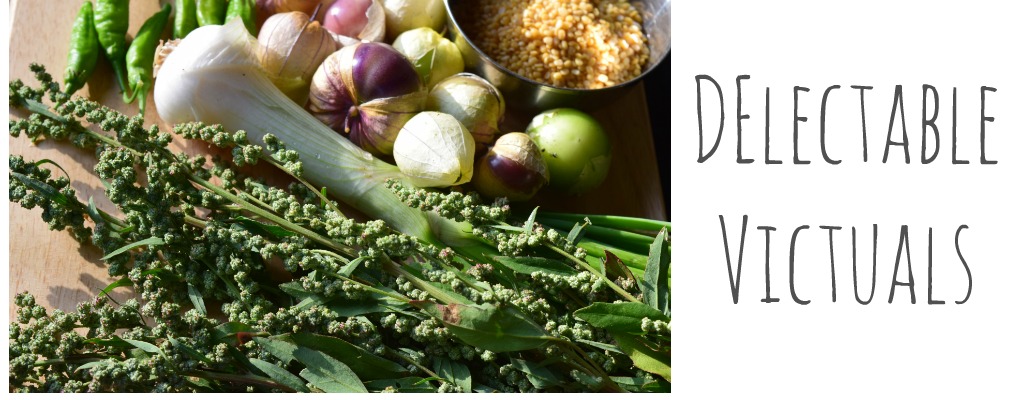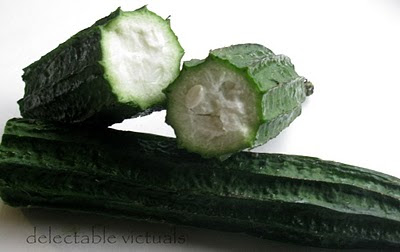
I remember roughly about a dozen or so varieties of
mangoes that I relished in my childhood: some best eaten raw, some best when ripe and golden, each with quite a distinct flavor and texture. Some were stringy, some were soft and fleshy; some were way too juicy that i just had to poke a hole, stick a straw and enjoy the juice and discard the mango.
Summer was the
mango season where I grew up. My mom used to make so many different dishes with mangoes - the raw green ones as well as ripe fruits.
Tiny raw baby mango
pickle is still one of my favorites: my mom used to just brine a batch and have it handy for snacking on; and then a larger batch was brined and soaked in a blend of spices including extra hot chili powder and mustard - we either called it "maa vadu" or "kadugu manga" - a wonderfully addictive pickle/achar/side that I loved eating with yougurt or buttermilk rice. My mom had special porcelain/earthenware jars/crock to store these in and they last for over a year, if we don't eat it all up first, that is.
Plus, of course various mango
chutneys, salads and
pachadis. By the end of each mango season we kids would have gorged so much that we couldn't handle the sight of another mango! Those were the days!
Many south Indian dishes seem elaborate as they involve some form of spice paste, plus some form of spice powder, but, I have found that making extra and saving it for future use makes it seem effortless the next time :)

Ingredients
2 medium raw green mangoes - one diced, one grated finely
4 cups cooked basmati rice
1 tsp turmeric powder
1 Tbsp canola oil
salt to taste
spice paste*:4-6 cloves of garlic
1" piece of ginger
4-5 green chilies
Spice powder:1 Tbsp urad dal
1 Tbsp chana dal
1 Tbsp mustard seeds
1
star anise1-2
bay leaves1-2 2-inch pieces of
Indian/Ceylon cinnamon bark (optional)
tempering:1 tsp mustard seeds
1 Tbsp chana dal (optional)
4-5 fresh curry leaves (optional)
1 Tbsp oil for tempering
Preparation
- Dice one mango (get as close to the pit as you can; and discard the pit) - i like to leave the skin on as it gives a certain texture and bite to the dish; alternately, skin and grate the mango, if preferred, instead of dicing; set aside
- Roughly chop the other mango; again, remove the skin if preferred
- Combine the chopped mango from step 2 and the spice paste ingredients in a blender or food processor and grind into a fine paste; set aside
- Dry roast the spice powder ingredients, and when cool enough to handle, grind them to a fine powder; set aside
- Heat the oil in a pan, add the spice paste and sauté till the raw flavor of garlic is gone and the spices release their aroma
- Add the diced mango, turmeric powder, spice powder from step 4, some salt and sauté till the diced mango softens a little and is not too raw
- Add the cooked rice, adjust salt to taste, stir till well incorporated
- Tempering: heat oil in a small pan/ladle, when oil shimmers add the mustard seeds; when mustard seeds splutter and die down, add the curry leaves and turn off heat
- Garnish with the tempering, serve warm with pappadam or vadaam.
I usually double or triple the quantities for the spice powders and spice paste and save a portion of them for later use. Spice pastes can be refrigerated for up to a month usually, and spice powders last even up to six months if stored in an air tight container.
While I prefer to make my own spice pastes and powders, I also try to have some store-bought ones to fall back on.
The quick and easy mango rice recipe here is adapted from
Dakshin by Chandra Padmanabhan, with variations, as I cannot follow a recipe without personalizing/customizing it somehow.
Labels: indian, mango, rice, vegetarian

















